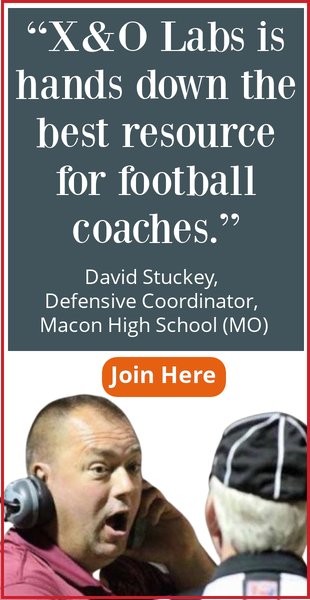By Mike Kuchar
Senior Research Manager/Co-Founder
X&O Labs
Twitter: @MikekKuchar
Once the game planning design is in or the “hay is in the barn” the next phase of the 95% method is executing the game plan. Here, all of Coach Longo's previous planning comes to fruition. He's asked to make real-time decisions on which concepts to call and adjust to any changes in defensive structure or personnel. We were given full access this past season into Coach Longo's game day operations procedure. We shadowed him as he prepared for an SEC opponent while at the University of Mississippi.
In this course, we present our research on the pre-game and game day activities he takes part in during the game week.
Pre-Game Operations
“Calling the Game” Simulation:
We found this activity to be instrumental for the in-game call procedure Coach Longo uses with his staff. It's a 30-minute session once a week where he and his graduate assistant (now offensive analyst) Josh Snow will sit down and simulate calling the game in real time. Coach Longo will present cutups of how the next opponent defended particular formations during the course of the season. He'll use his playlist and call a play concept while Coach Snow follows the protocol he uses during game day such as verbalizing the coverage and where the quarterback should go with the ball. It's real-time dialogue, without a pause button, that gets fined tuned so there is no wasted verbiage on game day.
“I like to have my graduate assistant in here with me so he gets a feel of how I will call a game,” said Coach Longo. “The more we do that the more he sees things the way I do. I need him to do that so he can give feedback to me thinking about the game, the plan or the play calls the way in which I think about it. You have to know why I'm calling the game. You have to have a complete understanding of the offense to be a great spotter."
According to Coach Snow, the process is immeasurable in helping him harmonize with Coach Longo on game day. "I get the reps just like the quarterback is getting the reps during the course of the week," he said. "That's really important to me. I hear all of Coach Longo's coaching points. And the more times I can see the game at game speed the more it helps me in the booth."
Applying the Read Sheet:
What Coach Snow is specifically looking at during these sessions is what Coach Longo calls the “read sheet.” It’s a play sheet that lists each play concept Coach Longo plans on using that week and next that concept is the most influential defender that can affect that play. It is Coach Snow’s responsibility in the booth to monitor that defender as the play unfolds.
While we can’t produce the actual read sheet for this report, we did notice the following:
- In zone schemes, the read defender will be the C gap defender
- In gap schemes, the read defender will be the backside linebacker.
- In bubble screens, the read defender might be the play side alley defender.
- In most dropbacks, the read defender might be the backside safety.
Once these defenders are identified, Coach Snow will monitor their post-snap actions. One example on the levels concept would be which route the Mike linebacker took. Or in the Shallow route, the defender that squeezed the dig would be the read defender.
Although Coach Snow has graduated from the read sheet- he’s been with Coach Longo for over five years- he says it’s helped train his eyes to interpret and discern information quickly. “It was awesome for me because it helped me learn the offense,” he said. “That is the easy way to understand how to help him.” While every concept has a read defender, sometimes those defenders will change on a weekly basis based on how a defense is deciding to take away particular schemes.
Coach Longo did make a point to say that those determinations are not always made after one rep of him doing it. It’s a pattern of behavior. “The defensive coordinator might be in a coverage where that safety needs to come downhill right now on one play,” said Coach Longo. “He may track harder in cover four than he would in cover two. We have answers for that.”
Coach Snow is also responsible for running the scout team defense where he will make the defensive scout sheet to fully immerse himself with the opponent’s defensive structure and personnel. “Many times, when we are devising personnel match-ups, I will put our match-up advantages in different color jerseys in practice so that we know who to exploit,” said Coach Snow.
Game Day Operations
The Walk-Through:
Even for home games, the University of Mississippi football team travels to stay in a hotel more than 45 minutes away from Oxford. It is at this location where the club will have its pre-game walk-through nearly three hours before game time. In the parking lot of the hotel, Coach Longo and his offensive staff recount every possible scenario that may present itself during the game. It’s a thorough, 30-minute session where Coach Longo will rattle off his entire play menu and signal in the tempo and formation in which these concepts planned to be used. The offense walks through their responsibilities in regimented fashion against a makeshift defense.









